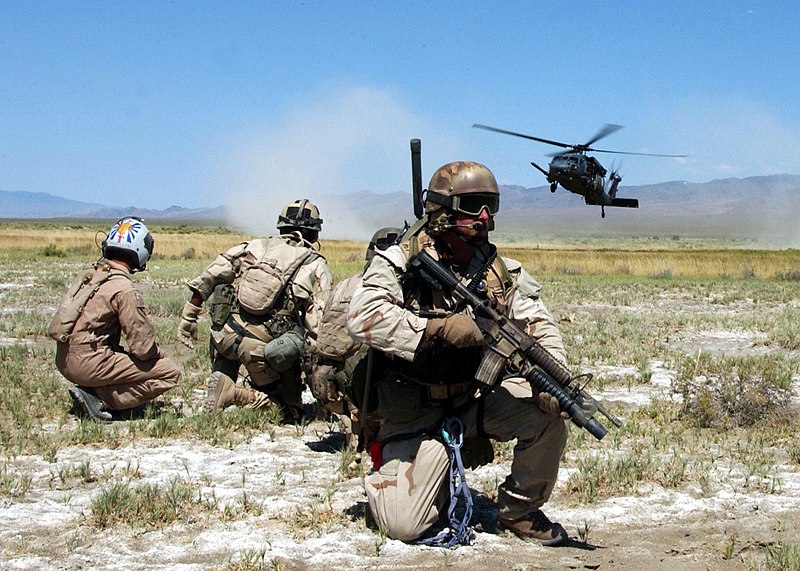Soaring Leadership: Lessons from Air Force Parajumpers

Embarking on a Journey of Extraordinary Leadership
Leadership is a multifaceted concept that transcends boundaries and manifests itself in various domains. One such domain that exemplifies extraordinary leadership is the realm of Air Force Parajumpers. These elite individuals, often referred to as “PJs,” undergo rigorous training and are tasked with executing high-stakes rescue missions in some of the most challenging and hazardous environments imaginable. Through their unwavering dedication, exceptional skills, and a deep commitment to saving lives, Air Force Parajumpers embody the essence of leadership in its purest form.
In this comprehensive article, we delve into the captivating world of Air Force Parajumpers to explore the invaluable leadership lessons and inspiring stories that emanate from their experiences. While their primary mission revolves around rescuing and providing medical aid to individuals in distress, the lessons they have learned along their journey extend far beyond their immediate field of expertise. These brave individuals face life-or-death situations with remarkable poise, making split-second decisions, leading teams, and navigating through adversity. Their stories not only captivate our imagination but also offer profound insights into the essence of leadership and its potential impact on individuals, teams, and organizations.
The profile of an Air Force Parajumper is nothing short of extraordinary. The selection process and training these individuals undergo are grueling, both physically and mentally, ensuring that only the most exceptional candidates make the cut. We will explore the key attributes and qualities required for success in this demanding role, focusing particularly on the leadership qualities that Parajumpers exhibit. From their ability to remain calm under extreme pressure to their strategic decision-making skills, Parajumpers exemplify the epitome of leadership in the face of adversity.
One of the most compelling aspects of Parajumpers’ leadership is their ability to thrive in high-stakes rescue missions. By examining specific rescue missions, we will delve into the leadership challenges encountered in these situations. We will dissect the decision-making process under severe time constraints, analyze the critical role of effective communication in high-pressure environments, and explore how Parajumpers’ adaptability and resourcefulness allow them to excel in dynamic and ever-changing circumstances. These experiences provide invaluable lessons in leadership that can be applied to a wide range of professional settings.
Effective leadership is predicated on the ability to build cohesive teams that function seamlessly, even in the most demanding situations. We will explore how Parajumpers foster collaboration within their units and the vital role leadership plays in creating a sense of shared purpose and unity. By encouraging open communication, trust, and mutual respect among team members, Parajumpers demonstrate the importance of creating an environment that fosters collaboration, where individuals can harness their collective strengths to achieve extraordinary results.
No journey towards leadership excellence is complete without overcoming adversity, and Air Force Parajumpers face numerous challenges that test their mettle. We will examine the inherent risks and obstacles they encounter and delve into the mental and emotional resilience they embody. Parajumpers’ ability to remain composed in the face of overwhelming stress, their unwavering determination to persevere, and their embrace of failure as an opportunity for growth provide profound insights into the characteristics required to navigate adversity and emerge stronger as leaders.
Central to the Parajumpers’ leadership ethos is the concept of leading by example. We will explore how these remarkable individuals embrace the role of mentors, sharing their experiences, knowledge, and wisdom with junior Parajumpers. By cultivating a culture of continuous learning, they inspire and motivate the next generation of leaders to strive for excellence, pushing the boundaries of what is possible.
As we embark on this exploration of the leadership lessons and stories of Air Force Parajumpers, it becomes evident that their experiences offer a wellspring of wisdom for leaders in any context. The dedication, bravery, and unwavering commitment to service exhibited by these extraordinary individuals inspire us to reflect on our own leadership journeys. By distilling the essence of their experiences, we can uncover valuable insights that will enhance our own leadership abilities and propel us towards achieving exceptional results.
Join us on this captivating journey into the world of Air Force Parajumpers as we unravel the depths of their leadership lessons and stories, illuminating the path towards becoming exceptional leaders in our own right.
The Profile of an Air Force Parajumper
Air Force Parajumpers, or PJs, represent the epitome of leadership and excellence within the military community. Their selection process and training are exceptionally rigorous, ensuring that only the most exceptional individuals are entrusted with the responsibility of executing high-stakes rescue missions. To fully grasp the leadership lessons derived from their experiences, it is crucial to understand the profile and qualities of these remarkable individuals.
Overview of the Selection Process and Training Required
The journey to becoming an Air Force Parajumper begins with a highly competitive selection process. Candidates undergo a series of physical and mental assessments designed to evaluate their suitability for the demanding role. The selection process tests not only their physical prowess but also their mental resilience, decision-making abilities, and problem-solving skills. Only a select few who possess the necessary qualities are chosen to continue on this arduous path.
Once selected, these individuals enter an intensive and comprehensive training program. The training regimen is notoriously challenging, both physically and mentally, pushing candidates to their limits and beyond. The objective is to develop well-rounded individuals who can operate effectively in extreme conditions and high-stress situations. The training includes rigorous physical conditioning, parachute training, combat rescue tactics, medical training, and survival skills, among other critical competencies.
Physical and Mental Attributes Necessary for Success
The role of an Air Force Parajumper demands exceptional physical fitness and mental fortitude. The challenging nature of their missions necessitates individuals who can endure the physical demands of rescue operations in austere environments. Endurance, strength, agility, and exceptional swimming abilities are prerequisites for success. Parajumpers must also possess the mental resilience to overcome fear, make split-second decisions, and remain composed in the face of adversity.
Beyond physical fitness, leadership qualities are paramount for Air Force Parajumpers. These individuals are expected to lead their teams, make critical decisions, and effectively communicate in high-pressure situations. They must demonstrate unwavering commitment, self-discipline, and the ability to inspire and motivate others. Leadership is not limited to commanding others but also includes leading by example, fostering trust and respect, and creating a cohesive team environment.
Emphasis on the Leadership Qualities Exhibited by Parajumpers
Air Force Parajumpers exemplify exceptional leadership qualities that set them apart. First and foremost, they possess an unwavering commitment to service and a genuine desire to save lives. This selfless dedication fuels their actions, enabling them to push through adversity and execute their missions with unwavering determination.
Courage is another prominent leadership quality exhibited by Parajumpers. They willingly place themselves in harm’s way to rescue and provide medical aid to those in need, often in the most dangerous and hostile environments. Their ability to overcome fear and act decisively serves as a testament to their courage and exemplifies the importance of bravery in leadership.
Effective decision-making is a critical leadership skill in the Parajumper community. Parajumpers are trained to make rapid assessments and judgments in high-pressure situations where time is of the essence. Their ability to analyze complex situations, weigh risks, and make informed decisions is vital to the success of their missions. This skill extends beyond the immediate rescue operations and is transferrable to various leadership contexts.
Adaptability and versatility are also fundamental attributes displayed by Parajumpers. They must be prepared to operate in diverse environments, including combat zones, natural disasters, and humanitarian crises. Their capacity to adapt to rapidly changing circumstances, think on their feet, and find innovative solutions is crucial to their success and underscores the importance of adaptability in leadership.
Furthermore, effective communication lies at the heart of Parajumpers’ leadership. Clear and concise communication is essential during rescue missions, where every second counts
Leading Under Pressure: Lessons from High-Stakes Rescue Missions
Air Force Parajumpers operate in some of the most high-stakes and challenging environments, where split-second decisions and effective leadership can mean the difference between life and death. By examining their experiences in high-pressure rescue missions, we can extract valuable leadership lessons applicable in a wide range of contexts.
Description of a Notable Rescue Mission Conducted by Parajumpers
To illustrate the leadership challenges faced by Air Force Parajumpers, we delve into the account of a notable rescue mission. This mission could involve scenarios such as retrieving injured personnel from a combat zone, rescuing civilians during natural disasters, or providing emergency medical assistance in remote and hostile locations. By exploring the intricacies of such missions, we gain insights into the multifaceted nature of leadership in high-stakes environments.
Analysis of the Leadership Challenges Faced in High-Stakes Missions
In high-pressure rescue missions, Parajumpers confront a myriad of leadership challenges. Time constraints, limited resources, and unpredictable circumstances demand leaders who can make informed decisions quickly. The urgency of these situations intensifies the complexity of decision-making, requiring leaders to assess risks, evaluate available options, and choose the most effective course of action.
Moreover, effective leadership in high-stakes missions necessitates clear and precise communication. Parajumpers must be able to convey critical information accurately to their team members, coordinating efforts and ensuring everyone is working towards the same objectives. Communication breakdowns can have severe consequences, making effective communication an indispensable leadership skill in these circumstances.
Discussion of the Leadership Lessons Learned from High-Stakes Rescue Missions
The experiences of Air Force Parajumpers offer profound leadership lessons that extend beyond their specific operational context. These lessons include:
-
Decision-making under Time Constraints: High-pressure situations require leaders to make timely decisions with incomplete information. Parajumpers demonstrate the importance of remaining calm, analyzing the available data, and relying on their experience and training to make informed choices. Leaders in any field can benefit from learning how to make effective decisions swiftly, considering the available resources and priorities.
-
Effective Communication in High-Pressure Situations: In rescue missions, clear and concise communication is essential for successful outcomes. Parajumpers prioritize effective communication, ensuring that critical information is relayed accurately and efficiently. Leaders can learn from their example, cultivating strong communication skills and creating a culture of open and transparent communication within their teams.
-
Adaptability and Resourcefulness in Dynamic Environments: High-stakes missions often unfold in dynamic and unpredictable environments. Parajumpers exemplify adaptability and resourcefulness by quickly adjusting their strategies and utilizing available resources creatively. Leaders can draw from this resilience, embracing change, fostering a culture of adaptability, and empowering their teams to find innovative solutions in challenging situations.
By studying the leadership exhibited by Air Force Parajumpers in high-stakes rescue missions, we gain invaluable insights into the core principles that underpin effective leadership in any context. The ability to make swift decisions, communicate effectively, and adapt to changing circumstances are invaluable skills that can be cultivated and applied by leaders across industries and sectors.
The leadership lessons derived from the experiences of Air Force Parajumpers highlight the importance of remaining composed under pressure, making well-informed decisions, and effectively coordinating teams in high-stakes environments. By incorporating these lessons into our own leadership practices, we can enhance our ability to lead effectively, navigate challenges, and achieve exceptional outcomes.
Building Cohesive Teams: The Importance of Collaboration
One of the fundamental pillars of leadership exhibited by Air Force Parajumpers is their ability to foster cohesive teams that work seamlessly to achieve their mission objectives. The significance of collaboration cannot be overstated, particularly in high-stakes and dynamic environments. In this section, we explore how Air Force Parajumpers build and nurture cohesive teams and the leadership strategies employed to create a culture of collaboration.
Examination of Teamwork and Collaboration within Parajumper Units
Within the Parajumper community, teamwork and collaboration are not merely buzzwords but integral components of their operational success. Parajumpers operate in highly demanding situations where each team member’s contribution is essential for mission accomplishment. They rely on one another’s expertise, skills, and trust to execute complex rescue missions successfully. By analyzing their teamwork dynamics, we can extract valuable insights into the foundations of effective collaboration.
Discussion of the Role of Effective Leadership in Fostering Teamwork
Effective leadership plays a central role in fostering teamwork and collaboration within Parajumper units. Leaders must create an environment where team members feel valued, empowered, and supported. They set the tone for teamwork by modeling collaborative behaviors, encouraging open communication, and establishing a shared sense of purpose and mission. Leaders understand that by fostering a culture of collaboration, they can leverage the collective talents and strengths of their team members to achieve exceptional results.
Exploration of Strategies Employed by Parajumpers to Build Cohesive Teams
Air Force Parajumpers employ various strategies to build cohesive teams capable of executing high-stakes rescue missions. These strategies include:
-
Establishing Shared Goals and a Sense of Purpose: Parajumpers ensure that every team member understands the mission objectives and the importance of their individual roles in achieving them. They cultivate a shared sense of purpose that binds the team together and drives their collective efforts.
-
Encouraging Open Communication and Trust Among Team Members: Effective communication and trust are the bedrock of successful teamwork. Parajumpers emphasize the importance of open and transparent communication channels, where team members can freely express ideas, concerns, and feedback. They foster an environment of trust, where individuals feel safe to share their perspectives and rely on one another’s expertise.
-
Training and Development Programs to Enhance Individual and Team Skills: Parajumpers invest in training and development programs to enhance individual and team capabilities. They continually hone their technical skills, improve their knowledge base, and engage in realistic simulations and exercises. By investing in their teams’ growth, leaders ensure that they are well-prepared to handle the challenges they may encounter.
By adopting these strategies, Parajumpers create teams that function as a cohesive unit, each member complementing and supporting one another. This collaborative environment enhances decision-making, problem-solving, and overall operational effectiveness.
The leadership lessons derived from the Parajumpers’ emphasis on teamwork and collaboration can be applied to various leadership contexts. Leaders across industries can learn the following key principles:
-
Establish a Shared Vision and Goals: Clearly communicate the organization’s vision and goals to create a shared sense of purpose and direction among team members.
-
Foster Open Communication and Trust: Create an environment where team members feel safe to voice their opinions, concerns, and ideas. Encourage open and transparent communication channels that facilitate effective information sharing and collaboration.
-
Invest in Training and Development: Provide opportunities for continuous learning and growth to enhance individual and team capabilities. Offer training programs, mentorship opportunities, and resources that enable team members to expand their skills and expertise.
By implementing these strategies and emphasizing collaboration, leaders can build cohesive teams that leverage diverse perspectives, skills, and experiences to tackle complex challenges and achieve outstanding outcomes.
In conclusion, Air Force Parajumpers’ emphasis on teamwork and collaboration serves as a testament to the transformative power of collective effort. The leadership strategies they employ to build cohesive teams provide invaluable insights into creating a collaborative culture that drives organizational success. By prioritizing collaboration in our own leadership endeavors, we can harness the collective strengths of our teams, optimize performance, and accomplish remarkable achievements.
Resilience in the Face of Adversity: Overcoming Challenges
Air Force Parajumpers operate in some of the most challenging and hazardous environments, where they face numerous risks and obstacles. Their ability to overcome adversity with resilience and determination serves as a testament to their exceptional leadership. In this section, we explore the inherent challenges encountered by Parajumpers and delve into the leadership lessons derived from their unwavering resolve in the face of adversity.
Inherent Risks and Challenges Faced by Parajumpers
Air Force Parajumpers operate in a wide range of challenging scenarios, including combat zones, natural disasters, and hostile environments. These circumstances present inherent risks, such as hostile fire, extreme weather conditions, and complex logistical challenges. Parajumpers must navigate through treacherous terrains, endure physically demanding situations, and execute their missions while prioritizing the safety of both themselves and those they rescue.
Mental and Emotional Resilience Demonstrated by Parajumpers
The demanding nature of their missions requires Air Force Parajumpers to possess exceptional mental and emotional resilience. They must confront fear, uncertainty, and adversity head-on, remaining composed and focused on their objectives. Parajumpers demonstrate unwavering determination, mental toughness, and the ability to adapt to rapidly changing circumstances. They embody a “never quit” mindset, allowing them to persevere even in the most challenging situations.
Leadership Lessons Derived from Overcoming Adversity
The experiences of Air Force Parajumpers provide valuable leadership lessons that can be applied in any context. These lessons include:
-
Maintaining Composure in High-Stress Situations: Parajumpers exhibit the ability to remain calm and composed under extreme pressure. Leaders can learn from their example by developing emotional intelligence, practicing mindfulness, and honing their ability to make clear-headed decisions amidst chaos.
-
Promoting a Culture of Perseverance and Determination: Parajumpers exemplify the power of perseverance and determination in the face of adversity. Leaders can foster a culture that encourages resilience by setting high standards, providing support, and recognizing and celebrating the efforts and achievements of their team members.
-
Embracing Failure as a Learning Opportunity and Fostering a Growth Mindset: Parajumpers understand that failure is an inherent part of the learning process. They view setbacks as opportunities for growth, continuously seeking ways to improve and adapt. Leaders can cultivate a growth mindset within their teams by encouraging experimentation, providing constructive feedback, and emphasizing a culture that embraces learning from mistakes.
By embracing the leadership lessons derived from the resilience of Air Force Parajumpers, leaders can navigate challenges more effectively, inspire their teams to overcome adversity, and foster an environment of continuous growth and improvement.
The stories and experiences of Parajumpers serve as a reminder that leadership is not only about achieving success but also about persevering through setbacks and challenges. By developing resilience within ourselves and our teams, we can navigate uncertainty, overcome obstacles, and emerge stronger as leaders.
The resilience demonstrated by Air Force Parajumpers in the face of adversity offers invaluable leadership lessons. Their ability to maintain composure, foster determination, and embrace failure as a learning opportunity inspires us to cultivate resilience within ourselves and our teams. By incorporating these lessons into our leadership practices, we can navigate challenges with grace, inspire our teams to persevere, and achieve remarkable results.
Leading by Example: Role Modeling and Mentorship
A critical aspect of leadership development within the Air Force Parajumper community is the emphasis on leading by example through role modeling and mentorship. Parajumpers understand the transformative power of sharing experiences, providing guidance, and fostering the growth of future leaders. In this section, we explore the importance of role modeling and mentorship, the mentorship programs and practices within the Air Force, and the impact of effective role modeling on leadership development.
Importance of Leadership Role Modeling in the Parajumper Community
Leadership role modeling serves as a powerful catalyst for growth and development within the Parajumper community. Parajumpers understand that their actions speak louder than words, and they embrace the responsibility of setting an example for their team members. By embodying the values, principles, and behaviors they expect from others, they inspire and motivate junior Parajumpers to strive for excellence in their own leadership journeys.
Mentorship Programs and Practices within the Air Force
The Air Force recognizes the importance of mentorship in leadership development and has implemented robust programs to foster mentorship relationships. These programs pair experienced Parajumpers with junior members, providing a platform for knowledge sharing, guidance, and support. Mentors offer valuable insights, share their experiences, and provide advice to mentees, helping them navigate their own leadership challenges and make informed decisions.
Impact of Effective Role Modeling and Mentorship on Leadership Development
Effective role modeling and mentorship have a profound impact on leadership development within the Parajumper community. The benefits extend beyond the transfer of knowledge and skills. They include:
-
Inspiring and Motivating Junior Parajumpers: Effective role modeling ignites a sense of inspiration and motivation among junior Parajumpers. Observing leaders who exemplify the qualities they aspire to cultivate fosters a strong desire to follow in their footsteps and become exceptional leaders themselves.
-
Sharing Valuable Experiences and Knowledge: Mentors play a vital role in sharing their experiences, knowledge, and wisdom with mentees. By imparting their insights gained from real-world scenarios, mentors accelerate the growth and development of mentees, equipping them with the tools and perspectives needed to tackle leadership challenges effectively.
-
Cultivating a Culture of Continuous Learning and Improvement: Through role modeling and mentorship, leaders cultivate a culture of continuous learning and improvement. They demonstrate that leadership is a lifelong journey, encouraging mentees to embrace growth opportunities, seek feedback, and constantly strive for personal and professional development.
The leadership lessons derived from the emphasis on role modeling and mentorship in the Parajumper community can be applied in various leadership contexts. Leaders across industries can adopt the following practices:
-
Be an Exemplary Role Model: Leaders should align their words and actions, consistently demonstrating the behaviors and values they expect from their team members. By embodying the desired qualities, leaders inspire and motivate others to emulate their example.
-
Establish Mentorship Programs: Organizations can implement mentorship programs that pair experienced leaders with junior members. These programs provide a platform for knowledge sharing, guidance, and support, enabling mentees to benefit from the wisdom and experience of their mentors.
-
Encourage Continuous Learning and Development: Leaders should foster a culture that values continuous learning and development. By providing resources, training opportunities, and encouraging a growth mindset, leaders inspire their teams to continuously strive for improvement.
By incorporating these practices into their leadership approach, leaders can create an environment where role modeling and mentorship flourish, cultivating a new generation of exceptional leaders.
The emphasis on role modeling and mentorship within the Air Force Parajumper community underscores the transformative power of leading by example. By serving as role models and engaging in mentorship relationships, leaders inspire, guide, and empower others to reach their full leadership potential. By integrating these practices into our own leadership journeys, we can foster growth, accelerate development, and create a culture of continuous learning and improvement.
Taking Flight: Applying Parajumper Lessons to Leadership Success
The leadership lessons and stories derived from the experiences of Air Force Parajumpers offer a wealth of insights and inspiration for leaders in any context. Their unwavering commitment to service, exceptional skills, and ability to lead under pressure exemplify the essence of effective leadership. Throughout this article, we have explored various aspects of their leadership, including the profile of an Air Force Parajumper, leading under pressure in high-stakes rescue missions, building cohesive teams through collaboration, overcoming adversity with resilience, and the power of leading by example through role modeling and mentorship.
The profile of an Air Force Parajumper showcases the exceptional qualities and attributes required for success in their demanding role. The rigorous selection process and comprehensive training ensure that only the most exceptional individuals are entrusted with the responsibility of executing high-stakes rescue missions. Their physical and mental capabilities, combined with their leadership qualities, set them apart as remarkable leaders within the military community.
In high-pressure rescue missions, Air Force Parajumpers face significant leadership challenges. The ability to make swift decisions under time constraints, effectively communicate in high-pressure situations, and adapt to dynamic environments are critical skills that leaders can learn from their experiences. These lessons highlight the importance of clarity, agility, and effective communication in navigating through challenging circumstances.
Air Force Parajumpers emphasize collaboration and teamwork as essential elements for mission success. By fostering a culture of collaboration, establishing shared goals, and encouraging open communication, they create cohesive teams that operate seamlessly. The lessons derived from their collaborative approach provide insights into the value of teamwork, trust, and effective leadership in fostering collective achievements.
The Parajumpers’ unwavering resilience in the face of adversity is a testament to their exceptional leadership. They exemplify the ability to remain composed under pressure, persevere through challenges, and embrace failure as an opportunity for growth. Their experiences underscore the significance of resilience, determination, and a growth mindset in navigating adversity and inspiring others to do the same.
Leading by example through role modeling and mentorship is a cornerstone of leadership within the Air Force Parajumper community. By embodying the qualities they expect from others, leaders inspire and motivate their team members to strive for excellence. Mentorship programs further enhance leadership development by providing guidance, sharing experiences, and fostering a culture of continuous learning and improvement.
The leadership lessons derived from the experiences of Air Force Parajumpers are not confined to their operational domain. They resonate across industries and sectors, offering valuable insights applicable to leaders in various contexts. By integrating these lessons into our own leadership practices, we can enhance our decision-making abilities, foster collaboration, navigate adversity with resilience, and inspire and mentor others to reach their full potential.
In conclusion, the leadership lessons and stories of Air Force Parajumpers serve as a source of inspiration and guidance for leaders seeking to excel in their respective fields. Their dedication to service, exceptional skills, and unwavering leadership provide a blueprint for success in high-pressure environments. By embracing the principles of leadership derived from their experiences, we can elevate our own leadership journeys, empower our teams, and achieve remarkable outcomes.






